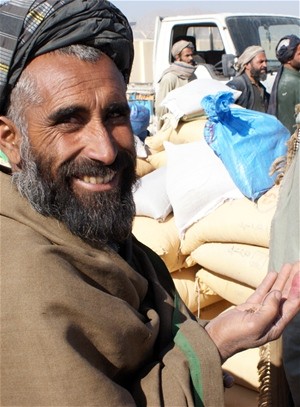
The seed and fertilizer distribution will impact more than 7,000 farmers in Kandahar City’s Dand District, an area that is enjoying the fruits of civic participation thanks, in part, to USAID stabilization projects.
IRD/AVIPA Plus
23 APRIL 2011 | KANDAHAR, AFGHANISTAN
Because of poor soil and arid growing conditions in the southern Afghan province, fertilizer is crucial for successful harvests. But quality fertilizer, when it can be found in local markets, is cost-prohibitive for most farmers.
Jalaludin is a farmer, not a scientist. But he knows how to tell the difference between good fertilizer and cheap imitations.
As he lined up for seed and fertilizer at a recent USAID distribution in Kandahar City, he took a pinch of diammonium phosphate fertilizer, ground it in his palm and touched it with the tip of his tongue. “See how it melts away? This is good fertilizer. If it doesn’t melt, it’s full of additives.”
Jalaludin received twelve bags of fertilizer and thirteen kinds of vegetable seeds but only had to pay around $100 for a package worth $500. For small-landholding farmers like Jalaludin this can mean the difference between subsistence and profitability. He and his family of eight farm approximately eight acres of land. In the past they were barely able to make a profit, but next year he hopes to sell his surplus production at the local market. “Perhaps one day we will even be able to export to other countries,” he said.
USAID’s Afghanistan Vouchers for Increased Production in Agriculture Plus project has brought greater cooperation between the local populace and the district government. Beneficiaries are chosen by local shuras working with the district governor and distributions take place at the district center. The seed and fertilizer bring prosperity while forging a stronger link between farmers like Jalaludin and their local leaders.







Comment
Make a general inquiry or suggest an improvement.